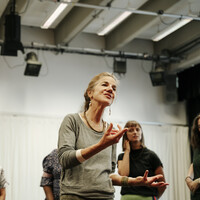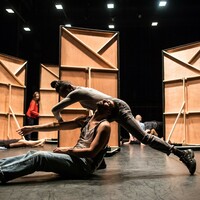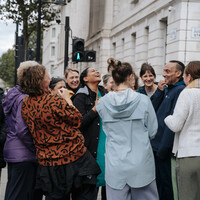Choreographer Maxine Doyle and rehearsal director Liam Riddick on working with BA students at London Contemporary Dance School

News Story

Maxine Doyle is an independent choreographer and director with an MA in choreography from the Laban Centre and is a recipient of the Bonnie Bird Choreography Award. She was Artistic Director of First Person Dance Company from 1996 – 2003. Since 2002 she has been an Associate Artist with Punchdrunk, for whom she has co-directed and choreographed many multi-award-winning productions. A documentary on Punchdrunk’s work, entitled Behind the Mask, premiered on Sky Arts in January 2023.
Maxine has worked in TV, theatre and opera across the globe, and has created dance theatre work for The BalletBoyz (UK), The Martha Graham Company (USA), Verve (UK) and Johannes Wieland Company (Germany) and is a regular principal artist at Springboard Dance Montreal, B12 Festival in Berlin and has mentored for the iconic Jacobs Pillow Dance Season.

Originally from South Wales, Liam Riddick was an NDCWales associate and Royal Ballet Junior associate, before studying contemporary dance at Coleg Gwent in Newport. This led him to London to complete his degree at London Contemporary Dance School. Upon graduating Liam joined Richard Alston Dance Company, touring nationally and internationally for 8 years. During his time in the company he was nominated 7 times in 6 consecutive years at the Critics Circle National Dance Awards. In February 2018 he won Best Male Dancer 2017.
Liam made his first professional work ‘fourfold’ on Blaenau Gwent based dance company FFIN Dance, and has choreographed on Ballet Cymru for their Made In Wales Season with ‘Murmurations’. He also created ‘flutter’ for The Brighton Academy. Liam was named a rising star in Graham Watt’s list of London’s Best Dance for his choreography in 2021.
Liam also spent 2 years touring with the acclaimed BalletBoyz, and was part of the original cast for Bradley 4:18 by Maxine Doyle. In 2023 Liam became Rehearsal Director for Balletboyz for their show ‘England On Fire’ and is continuing to work with them throughout 2024. He is now bringing Bradley 4:18 to stage with our final year BA students at London Contemporary Dance School, working as a rehearsal director with Maxine Doyle.
How have you found working with our students?
LR: They are great. I feel very lucky. They are very enthusiastic and curious. It can be hard sometimes learning a piece that already exists, especially when something has been created on another dancer and you want to mimic or copy, but I’m trying my hardest to let them bring their own personal characters and attributes to the work. I am putting the bar way up high and they are striving – which is great! It’s nice to see a new cohort of artists coming up and thriving.
MD: When I was approached to create something or offer a piece of repertoire for the third years, I immediately thought about this work that I’d made with the BalletBoyz. It was a piece made for six young men. Physically it’s super challenging, it’s theatrical, I thought it could be interesting on a larger group and it would be interesting to play with the genders of it.
What does it feel like to bring a seminal piece back to live interpreted by a new generation?
LR: I was in the original work in 2020, so it was interesting for me coming back to it and seeing it in a different light. It was originally created for 6 dancers and now I am remaking it on 20, so that's fascinating. Seeing this singular character that the piece follows played by 20 different personalities is fascinating. I get to play and see what I can pull out of them and how far I can stretch the character.
MD: The movement language is not shifting or changing. This piece is quite violent. The character of Bradley was inspired by the lyrics of a Kate Tempest song, Pictures on a Screen. It was about this particular young man, but actually the piece ended up being so much about a kind of human being, a kind of personality, a kind of moment in time. I’m interested to see how the movement translates physically on a range of different bodies. We’ll see today whether politically it feels great, or feels strange or odd. I’m imagining it really becomes about a kind of sense of human expression.
The dance industry has changed a lot since. Do you see the work with different eyes now or how has it changed?
MD: I haven’t been back in an educational setting for a long time. It feels like things are more transparent. The world has shifted a lot, the way we use spoken language, the way we communicate with each other, the way hierarchies are dissolving – I've appreciated that. I haven’t been in a room with undergraduates in... I can’t remember!
But this is really Liam’s project. I actually feel like he was the best person to do this, because often as a choreographer I work collaboratively with the dancers, they make the movement language. I wouldn’t have been the right person to have gone in and remade this. It needed to be one of the dancers who owned the movement language to be having this engagement with the students.
LR: The essence of Bradley, the character we follow, is still there, but I see Bradley now in a different light. It’s nice to bring the character back to life, and see different particles of things that we have explored in the past.
The piece is quite physical and aggressive, it is about the frustration of this tormented character and there is a lot of physical violence in it. We have had lots of conversation about how we were going to approach that, and I really enjoyed how open-minded the students are. We problem-solve and we figure it out together, so I feel they are as much a part of bringing this piece to life as I am
How does it feel to have started alone as a choreographer, and now feel confident in the people that you’re trusting your work with?
MD: My collaborative process is very much inspired by the people in the room. Often I create a strong aesthetic, a world, strong themes and ideas, but the movement language comes from the individual. There’s always a huge amount of trust between me and the dancers anyway, and a dependency on their skill and their artistry.
The focus for me was always about the process and the experience with the students. The process is more important than the work itself. It’s really about them embodying it and finding it. This work was made on one company of dancers, and remade on another company, and it looked different on each company. I like that process of translation.
Keeping repertoire alive is not something we are necessarily very good at in contemporary dance. Why is it important to revisit work as well as look forward?
MD: I suppose dance by its very nature is really ephemeral. Bradley was premiered just before COVID, it did three shows, then was shut down. Then it had quite a big onscreen presence, then it was reworked and had a good tour – about 30 shows. This felt like a good opportunity to bring it back again.
I think you learn a lot through creation, through making, through being in a process right from the beginning. But equally, as a working professional dancer, you will have to learn and interpret works that might be decades old. There’s a skill to that – it trains a different part of the brain and body.
LR: I think it is the most important thing to revisit work that already exists and has come from a place that has helped lay the foundations of where the industry is now. If it wasn't for these works and their level of masterfulness, the dance world wouldn't be the worlds it is. It’s amazing how much the world has progressed and changed and evolved but we have to keep the past alive.
Bradley, Flowers, Smithereens is a very exciting triple bill of three high caliber choreographers. How do you feel about the opportunity for audience to see contemporary dance work curated in this way?
MD: I think it’s cool. This week I thought – how fun! How great for the students to experience such different work, and what a nice opportunity for the audience to experience such different works. The show wasn’t curated necessarily, but I feel like there’s going to be some interesting parallels between the three of us as artists. Wilton’s is such a gorgeous venue – such a nice opportunity for an audience to see these works. They are really embodied with the energy of this youthful dance.
LR: The student are going to offer three completely different visions, and different worlds, and you will come away enriched with three fully formed ideas. I think it will be a treat for audience!
Is there anything you’d want to say to dancers who are deciding whether they want to pursue a career in the performing arts industry?
The life of an artist is amazing. It’s a privilege to work in this industry. One of the best things about my job is just always working with inspiring people. But it is very tough. You could have a huge amount of talent, but if you don’t have the drive, if you don’t have the tenacity, if you’re not a self-starter, there’s no point actually. It has to be the only thing you want to get up and do in the morning, especially if you’re starting out.
But in some ways I feel like it’s easier than it was when I was younger, social media can be amazing, technology is amazing, you can research, and resource and create and make in a way that 20-30 years ago was much, much harder. But still, I think if you’re not really driven to make a difference in the industry somehow – then I would say just do it for the love.


